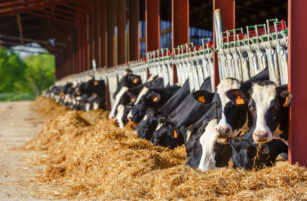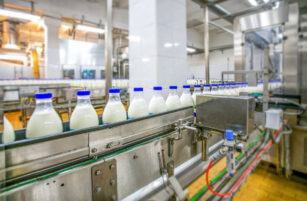Insight Focus
Whey protein is a high-quality protein from milk. It comes in forms like sweet whey, concentrate, and isolate. Popular in the growing protein supplement industry, it’s also used for weight management, health products, and animal feed.
What Is Whey Protein?
Whey protein is a high-quality protein derived from milk during the cheese-making process. Milk contains two main types of protein: casein (80%) and whey (20%).
When milk is coagulated to form cheese, whey is the liquid part that separates from the curds. This liquid is then processed, purified, and dried to create whey protein powder.
While whey usually comes from the cheese stream, it can also be sourced from the casein stream, which includes various types of casein powders such as acid casein, rennet casein, and lactic casein.
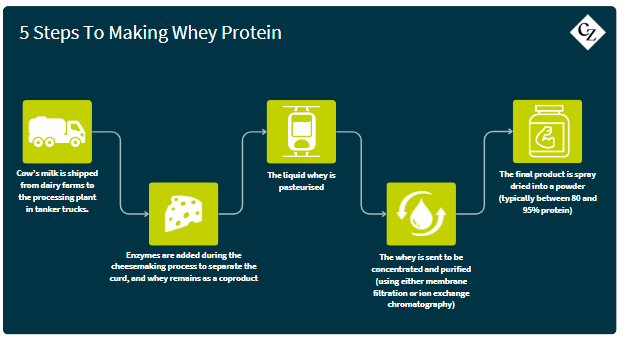
Types of Whey Protein
Whey protein comes in several forms, each with distinct levels of processing and protein concentration.
1. Sweet Whey Powder (SWP)
This is the least processed form of whey and the most affordable. SWP has lower protein content compared to other whey products, typically around 10-15%, but it is rich in lactose. This makes it valuable for use in both animal feed and human food products, such as baked goods, confectionery and dairy products. Its affordability and wide range of applications drive significant global demand.
2. Whey Protein Concentrate (WPC)
WPC can be split into two main categories: WPC34 and WPC80.
WPC34 contains about 34% protein and is commonly used in processed foods and snacks due to its lower protein content and relatively lower cost.
WPC80 is a more concentrated form, with around 80% protein, and is popular in fitness supplements and higher-protein food products. Because it undergoes more processing than SWP or WPC34, it offers a higher protein content but at a higher price point.
3. Whey Protein Isolate (WPI)
A highly refined form of whey with at least 90% protein. Most of the fats and lactose are removed during processing, making it suitable for those who are lactose intolerant or looking for a leaner protein source. WPI is favoured by athletes and individuals aiming for high protein intake with minimal additional calories.
4. Whey Protein Hydrolysate (WPH)
This is the most processed form of whey protein. It is pre-digested into smaller peptides, allowing for faster absorption by the body. This form is often used by athletes who need quick recovery after workouts or individuals with digestive sensitivities who require easier-to-digest proteins.
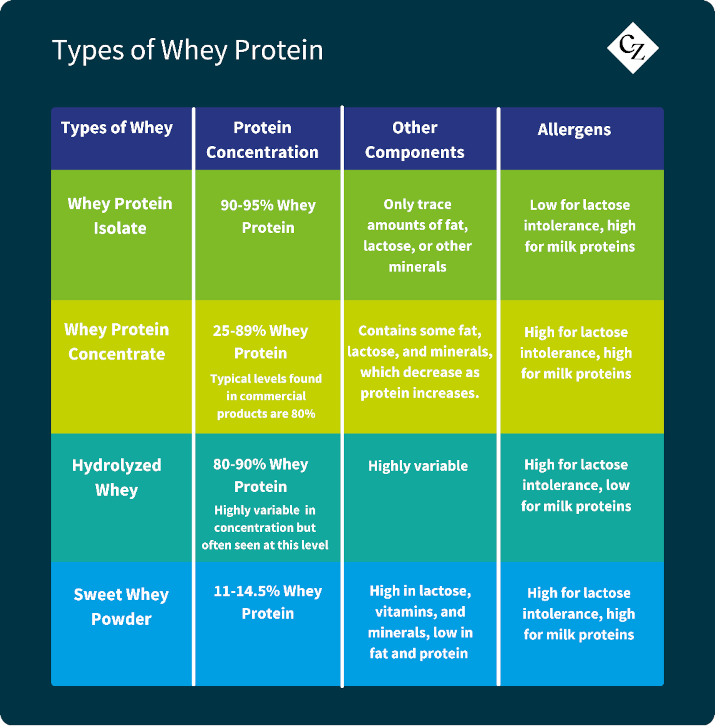
Growth of Protein Supplement Industry
Whey protein is primarily recognised for its role in the sports and workout industry, where athletes and bodybuilders use it for muscle recovery and growth due to its fast absorption rate and high branched-chain amino acid (BCAA) content, especially leucine. This makes whey protein an effective choice for post-workout recovery, as its high leucine levels stimulate the mTOR pathway, a key regulator of muscle growth.

Studies show that consuming whey protein after resistance training results in greater muscle protein synthesis compared to other sources, such as soy or casein, which do not provide the same immediate benefits due to their lower leucine levels or slower digestion rates.
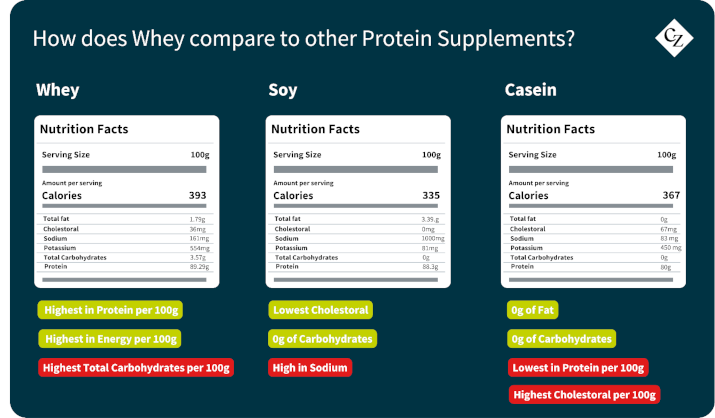
Source: USDA
This rising awareness of protein’s benefits, especially for muscle recovery, weight management, and overall health, has paralleled the rapid growth of the protein supplement market. Once a niche product for bodybuilders, protein supplements have gained mainstream appeal, with a notable increase in high-protein food and drink product launches. For instance, the percentage of products with high-protein claims rose from 3.3% in 2016 to 6.1% in 2020, reflecting growing consumer interest.
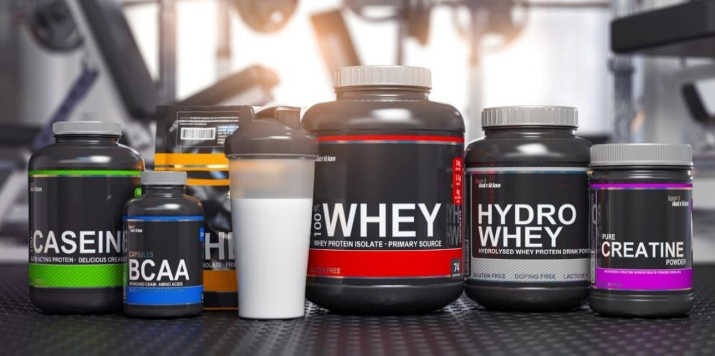
As fitness trends such as high-intensity interval training and strength training grow in popularity, more people—including casual gym-goers—are turning to protein powders, bars, and shakes to meet their nutritional needs.
This demand has driven significant industry growth, with major food companies introducing protein-enriched versions of popular snacks and making substantial acquisitions to capitalise on the trend. For example, Mondelēz International’s GDP 200 million purchase of protein bar brand Grenade in 2021, and Kellogg’s USD 600 million acquisition of RXBar in 2017, highlight the growing market for protein supplements.
The US, with the highest number of gyms and gym members worldwide, exemplifies this increasing focus on fitness and nutritional support, driving the sustained demand for protein supplements across diverse consumer groups.
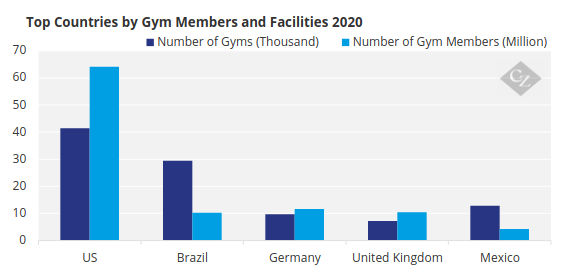
Source: IHRSA
Supporting Elderly Health with Whey
Whey protein is not only beneficial for athletes but also plays a crucial role in supporting the health of older adults. Maintaining muscle mass is vital for overall well-being as individuals age. A study published in the Journal of Nutrition, Health and Aging revealed that nearly 46% of individuals aged 51 and older do not meet their daily protein recommendations.
This inadequate protein intake poses challenges for muscle maintenance and increases the risk of sarcopenia, the age-related loss of muscle mass.
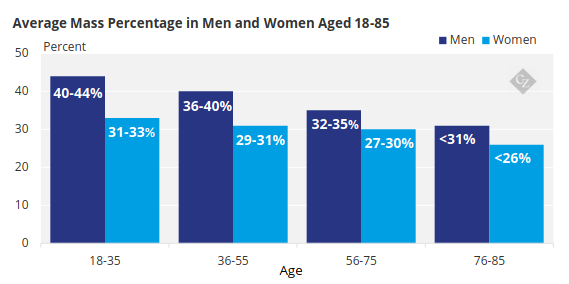
Source: Journal of Applied Physiology
Whey protein, with its high biological value and rapid absorption rate, emerges as an effective supplement to help meet these nutritional needs. A recent Harvard study emphasises the positive influence of protein supplements, particularly whey, on muscle health among older adults.

The research indicates that whey protein not only aids in muscle recovery but also enhances muscle protein synthesis when combined with resistance training. This combination can be particularly beneficial for the elderly, helping counteract the natural decline in muscle mass and strength that occurs with aging.
Whey as Animal Feedstock
On top of its benefits for humans, Whey is also a valuable component in animal feed, particularly for young animals like calves, lambs and piglets. It is widely used in milk replacers for early weaning, providing essential nutrients that support growth and health.
Whey products, rich in high-quality proteins, lactose, vitamins, and minerals, are well-suited for rearing animals for herd replacement or meat production. These ingredients help address common challenges such as digestive issues and stress-related health problems during early development.
For piglets, whey has been instrumental in promoting gut health and growth, especially as alternatives to antibiotics are increasingly sought after. Its high lactose content supports energy needs and gut function, while whey proteins, including key amino acids, contribute to muscle development and immune health. Additionally, its excellent solubility, digestibility, and palatability make it a practical and cost-effective component in animal feed, enhancing its overall suitability for promoting healthy development in piglets.

Whey processing today is highly advanced, using sophisticated technologies to produce a wide range of powders with specific nutrient profiles. These powders, ranging from high-protein to high-lactose formulations, cater to different dietary needs and help maintain animal health and growth.
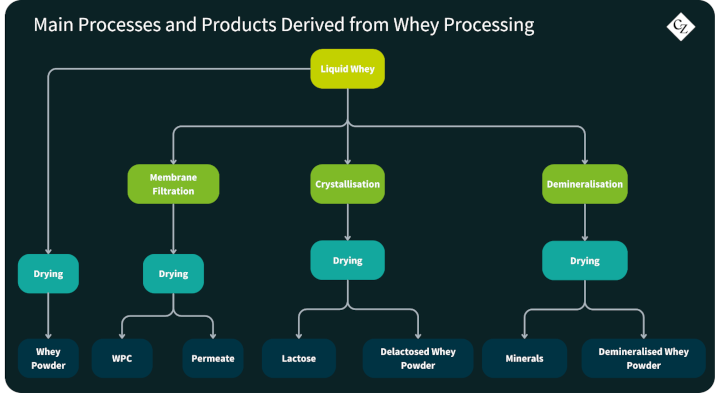
While some whey products are suitable for human consumption, others are specifically processed for animal feed. The precision of modern whey processing allows feed-ingredient buyers to customize their purchases, ensuring optimal nutrition for young animals while supporting sustainable and efficient farming practices.
Additionally, with global population growth leading to increased food demand, there will be a greater need for livestock and, consequently, a higher demand for whey protein as animal feed.
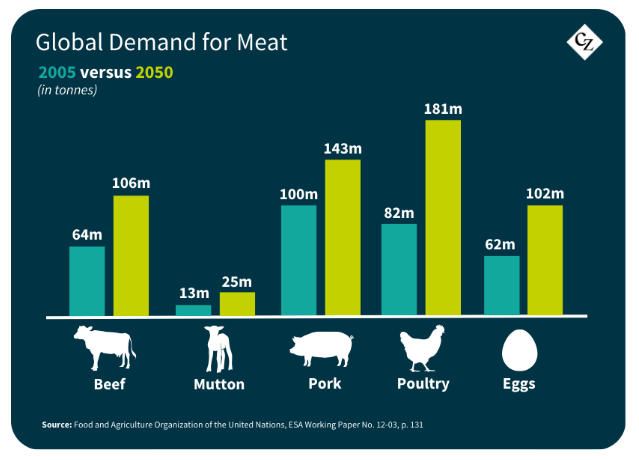
Dominance of US in Global Market
Since 2016, the US has been the top exporter of whey, leading the global market with its substantial production capabilities. Following the US, countries in the EU, particularly France, Germany, and the Netherlands, also play significant roles in whey exports. New Zealand contributes notably to whey production as well, with major companies like Fonterra, supported by the country’s strong dairy industry.
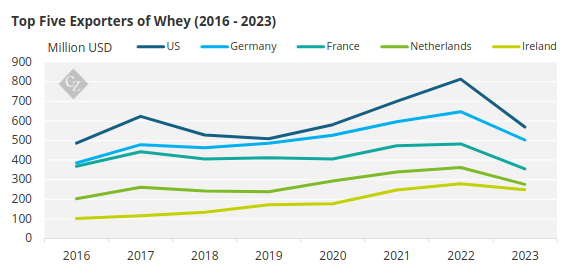
Source: TRIDGE
The US exports whey products globally, with China as its largest customer. China imports more than twice as much whey protein isolate (WPI) as Japan, the next largest importer.
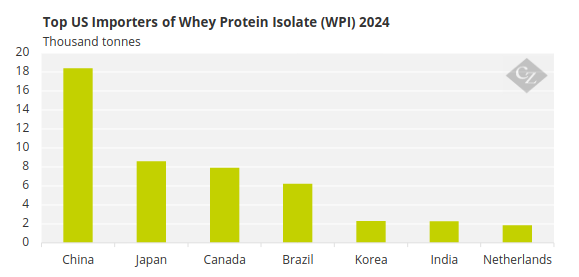
Source: CLAL
China is the leading global importer of whey, with several other Asian and European countries following closely behind. A significant portion of China’s whey imports consist of sweet whey protein (SWP), primarily used in the pork industry. This highlights the crucial role of whey protein as a key ingredient in animal feed.
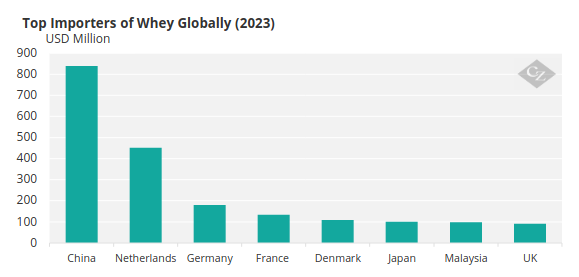
Source: TRIDGE
Looking ahead, the US whey protein market is expected to experience significant growth, driven by rising demand from both domestic and international consumers. Significant investments have been made in expanding processing capacity to meet this growing demand for cheese, with several new cheese plants set to open in 2024 and 2025.
According to a recent USDA dairy market report, this expanded capacity, along with accelerated growth in milk production, is expected to drive a 2% increase in cheese production, totalling 6.5 million tonnes. As these new cheese plants come online, they will enhance the supply of whey, potentially supporting further market expansion, with dry whey prices projected to increase in 2024.
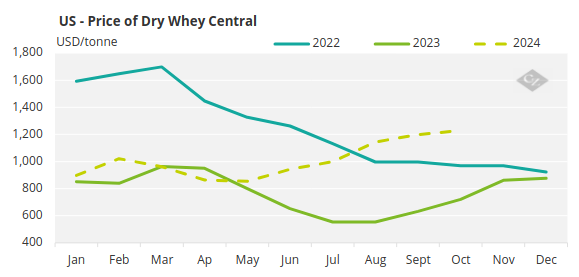
Source: USDA
Globally, the future of whey protein looks promising, driven by increasing consumer demand for health and fitness products. As more people adopt active lifestyles and prioritise nutrition, the whey protein market is expected to expand significantly.
More, as the world’s agricultural systems struggle to feed a growing population, there is likely to be higher demand for protein in a more concentrated form – a demand that can be addressed by whey protein.
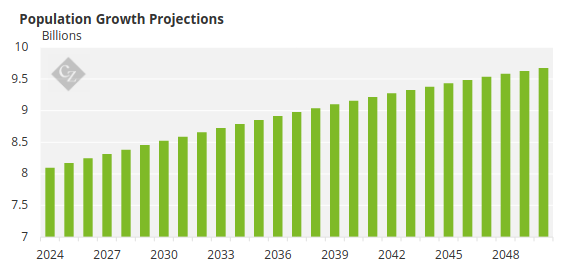
Source: World Bank




